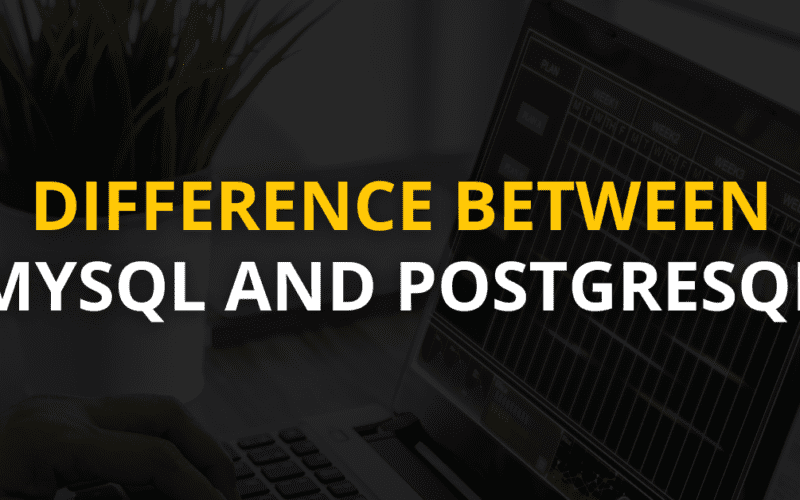Summary: PostgreSQL vs MySQL are leading RDBMS options catering to diverse needs. MySQL suits simple, read-heavy workloads, while PostgreSQL excels in complex queries and extensibility. Understand their key differences to choose the right database for your project.
Introduction
Relational database management systems (RDBMS) are essential for efficiently handling, storing, and organising structured data. These systems allow users to perform key operations like creating, reading, updating, and deleting data (CRUD).
With the global RDBMS market projected to reach USD 171.93 billion by 2030, growing at a 12% CAGR from 2024, their significance in powering modern applications cannot be overstated.
This blog explores PostgreSQL vs MySQL, two popular RDBMS solutions, highlighting their differences to help you choose the right one for your needs. By understanding their features and applications, you can make informed decisions aligned with your business objectives.
Key Takeaways
- PostgreSQL handles complex queries, extensibility, and large-scale data efficiently.
- MySQL excels in simplicity, speed, and read-heavy applications like web platforms.
- PostgreSQL supports advanced data types like JSON and custom types; MySQL offers basic types.
- PostgreSQL provides better scalability and robust replication options than MySQL.
- Licensing freedom makes PostgreSQL a preferred choice for avoiding vendor lock-in.
Overview of MySQL
MySQL is a widely used relational database management system (RDBMS) developed by the Swedish company MySQL AB and is now owned by Oracle Corporation. It is open-source and uses Structured Query Language (SQL) to manage and manipulate data. Its simplicity, reliability, and performance have made it popular for web applications, data warehousing, and e-commerce platforms.
Core Features of MySQL
MySQL stands out for its speed and efficiency in managing databases. It offers robust support for multi-user access, making it ideal for web-based applications with high traffic.
Key features include data replication, partitioning, and compatibility with storage engines like InnoDB, MyISAM, and Memory. Its ease of use and support for standard SQL syntax have contributed to widespread adoption across diverse industries.
Scalability and Flexibility
MySQL can handle databases ranging from small-scale applications to enterprise-level solutions. Its scalability ensures smooth performance, whether managing a few rows of data or handling millions of transactions. The system is compatible with multiple platforms, including Windows, Linux, and macOS, enhancing its flexibility for developers.
Community and Ecosystem
One of MySQL’s most substantial assets is its vibrant community. This global network of developers, contributors, and users provides extensive support, tutorials, and plugins, making integrating MySQL into various ecosystems easier. Additionally, its commercial version, MySQL Enterprise, offers advanced features like security, monitoring, and enterprise-level support for organisations with more complex needs.
Why Choose MySQL?
MySQL is an excellent choice for organisations seeking a reliable and efficient database solution. Its lightweight architecture, broad compatibility, and cost-effectiveness make it particularly attractive for startups, small businesses, and web application developers.
Overview of PostgreSQL
PostgreSQL is a powerful and advanced relational database management system (RDBMS) known for its extensibility, robustness, and standards compliance.
Initially released in 1989 as part of the POSTGRES project at the University of California, Berkeley, it evolved into an open-source project in 1996. Often called “Postgres,” it supports both SQL and JSON querying, making it a hybrid database ideal for modern application needs.
Core Features of PostgreSQL
PostgreSQL offers a wide array of features designed to meet the demands of complex applications. It supports advanced data types, such as arrays, JSON, and XML, enabling it to handle structured, semi-structured, and unstructured data.
Its support for ACID (Atomicity, Consistency, Isolation, Durability) transactions ensures data integrity even in critical operations. PostgreSQL also excels in indexing, offering options like B-tree, GiST, and GIN indexes for faster query processing.
Extensibility and Flexibility
One of PostgreSQL’s standout qualities is its extensibility. Developers can add custom functions, define new data types, and create custom plugins for specific use cases.
Its ability to integrate with languages like Python, Java, and Perl makes it a favourite for projects that require flexibility. PostgreSQL is also cross-platform, running seamlessly on Windows, Linux, macOS, and Unix-based systems.
Community and Ecosystem
PostgreSQL has a robust and active community that continuously improves its functionality. Its open-source nature allows developers worldwide to contribute plugins, extensions, and performance optimisations. The community also offers extensive documentation, tutorials, and troubleshooting resources, fostering widespread adoption.
Why Choose PostgreSQL?
PostgreSQL is ideal for applications requiring complex data handling, high scalability, and custom functionalities. It is widely used in analytics, data warehousing, geospatial systems, and enterprise-level applications, making it a versatile choice for modern database needs.
Key Differences Between MySQL and PostgreSQL
MySQL and PostgreSQL are two of the most popular relational database management systems, each catering to diverse needs in the database world. While both are open-source and capable of handling vast amounts of data, they differ significantly in their design, performance, scalability, and feature sets.
Understanding these differences can help businesses choose the database for their specific use case. Below, we explore the key distinctions between MySQL and PostgreSQL in detail.
Architecture and Design Philosophy
MySQL focuses on simplicity and performance. Its architecture is designed to provide straightforward solutions for common database use cases. MySQL prioritises ease of use, making it ideal for web applications and scenarios where rapid deployment is key. The database’s design leans heavily toward read-heavy workloads, offering fast query execution without overly complex configurations.
PostgreSQL, on the other hand, is built for extensibility and compliance with strict standards. It adheres closely to the SQL standard while allowing users to customise the database with extensions, stored procedures, and triggers.
PostgreSQL’s architecture is highly flexible, supporting many data models and workloads. This makes it a favourite for applications requiring advanced functionality, such as geospatial databases or analytics platforms.
Performance
MySQL shines in scenarios where simple, read-heavy queries dominate. It is optimised for speed, particularly in applications where data consistency and complex query handling are secondary concerns. With its default storage engine, InnoDB, MySQL delivers solid performance in transactional applications while maintaining a lightweight footprint.
PostgreSQL excels in handling complex queries and data transformations. Its advanced query planner and optimiser make it a strong choice for analytical workloads. Additionally, PostgreSQL performs exceptionally well in high-concurrency environments, ensuring stable performance even when multiple users or processes access the database simultaneously.
Scalability
Both databases offer scalability, but their approaches differ.
MySQL scales well vertically, meaning it performs better when running on more powerful hardware. It also supports basic horizontal scaling using replication, allowing read operations to be distributed across multiple replicas. However, its native support for sharding (distributing data across multiple servers) is less robust than PostgreSQL.
PostgreSQL supports vertical and horizontal scaling, offering advanced solutions like partitioning and logical replication. Its compatibility with third-party tools, such as Citus, enhances its scalability further, making it suitable for large-scale, distributed systems.
Data Types
PostgreSQL leads in supporting a wide range of data types. Beyond standard types like integers and strings, it supports arrays, JSON, XML, and even custom types defined by the user. This makes it an excellent choice for applications requiring complex or hierarchical data structures, such as content management systems or scientific research databases.
MySQL offers support for JSON data but lacks the depth and flexibility found in PostgreSQL’s implementation. While it covers basic data types adequately, it does not provide the same level of customisation or advanced features, limiting its utility in some use cases.
Features
Firstly, MySQL and PostgreSQL are ACID-compliant, ensuring reliable transaction management. However, PostgreSQL offers finer control over transaction isolation levels, which benefits applications requiring precise data consistency.
Secondly, PostgreSQL supports advanced indexing techniques, including GIN (Generalized Inverted Index) and GiST (Generalized Search Tree), enhancing its performance in full-text and geospatial queries. MySQL provides basic indexing features that are sufficient for most common use cases.
Lastly, MySQL offers simple replication setups, making it easy to implement read replicas. PostgreSQL, however, provides more sophisticated replication options, including logical and streaming replication, allowing greater flexibility in managing distributed systems.
Extensibility and Plugins
PostgreSQL stands out for its extensibility. Users can create custom data types, functions, and operators, enabling the database to adapt to unique requirements. A vast ecosystem of extensions, such as PostGIS for spatial data or pg_stat_statements for query monitoring, further enhances its capabilities.
MySQL also supports plugins, but its ecosystem is less extensive or versatile than PostgreSQL’s. While MySQL allows some customisation, it is less focused on extensibility, prioritising simplicity.
Compliance
PostgreSQL complies with SQL standards, adhering to strict ACID principles and supporting advanced features like full outer joins, common table expressions (CTEs), and window functions. This makes it an excellent choice for applications requiring complex SQL queries and strict data integrity.
While ACID is compliant with the InnoDB storage engine, MySQL has historically deviated from SQL standards in certain areas, such as its handling of GROUP BY clauses. While these differences may not impact all applications, they can pose challenges for developers migrating from other SQL-compliant systems.
Licensing and Cost
Both MySQL and PostgreSQL are open-source, but their licensing models differ.
MySQL is licensed under the GNU General Public License (GPL), but Oracle Corporation controls its development. This dual licensing model has raised concerns about potential limitations in the free version.
PostgreSQL, licensed under the more permissive PostgreSQL License, offers greater freedom for modification and redistribution. Its community-driven development model ensures it remains fully open-source without restrictions, making it a preferred choice for organisations wary of vendor lock-in.
Use Cases and Applications
MySQL and PostgreSQL, as robust relational database management systems, cater to distinct needs in the tech ecosystem. Their differences make each one particularly suitable for specific use cases. Choosing the proper database depends on your project’s goals, workload, and scalability needs. Let’s explore scenarios where MySQL and PostgreSQL perform exceptionally well.
Situations Where MySQL Excels
MySQL shines in environments where simplicity, speed, and reliability are paramount. It is widely used in web applications because it efficiently handles large volumes of read-heavy operations. Platforms like WordPress, Drupal, and Joomla rely on MySQL for dynamic content delivery and user interaction due to its optimised query performance and straightforward architecture.
For e-commerce platforms, MySQL ensures fast transaction processing and supports multi-user environments effectively. Additionally, developers prefer MySQL for lightweight and highly responsive content management systems (CMS). Its broad compatibility with different hosting environments makes it a default choice for small to medium-sized applications with limited complexity.
MySQL’s replication capabilities also make it ideal for scenarios requiring read scalability. It allows applications to distribute database reads across multiple servers without overloading the primary node.
Scenarios Where PostgreSQL is Better Suited
PostgreSQL outperforms when handling complex analytical queries and data modelling. Its advanced features, such as support for JSON, arrays, and user-defined types, make it a robust choice for data-driven applications like business intelligence tools or geospatial systems. PostgreSQL’s adherence to SQL standards and ACID compliance ensures reliable transactions for mission-critical operations.
PostgreSQL efficiently processes massive datasets for data warehousing, allowing organisations to perform real-time analytics without compromising data integrity. Scientific applications and financial systems leverage PostgreSQL’s robust indexing and querying capabilities to store and analyse intricate datasets accurately.
If your project demands flexibility, scalability, and extensibility, PostgreSQL is often the preferred choice, especially for long-term data-intensive projects.
Pros and Cons
MySQL and PostgreSQL are powerful databases that cater to different needs. Understanding their strengths and weaknesses will help you decide which database suits your use case. Below, we break down the advantages and disadvantages of each to provide a clearer picture of their capabilities and limitations.
Advantages of MySQL
MySQL is known for its simplicity and speed. It excels in read-heavy applications like content management systems and web platforms. Its wide adoption ensures extensive community support and readily available documentation. MySQL is lightweight, which makes it ideal for projects requiring quick deployments. Compatibility with numerous third-party tools and integrations enhances its flexibility for developers.
Disadvantages of MySQL
MySQL fails to handle complex queries and advanced features like parallel query execution. While ACID-compliant, certain transactional features are limited in its default configurations. MySQL’s strict focus on performance can compromise its ability to handle highly concurrent, complex workloads. Additionally, its licensing terms for enterprise use under Oracle may pose challenges for some organisations.
Advantages of PostgreSQL
PostgreSQL is a feature-rich, open-source database designed for robustness and extensibility. It supports advanced data types, full-text search, and JSON/array storage, making it suitable for modern applications.
PostgreSQL’s adherence to SQL standards ensures reliability for developers requiring strict data integrity. Its support for parallel queries, indexing options, and concurrency control makes it a strong choice for data analytics and high-traffic environments.
Disadvantages of PostgreSQL
PostgreSQL’s rich feature set comes with a learning curve. Its complexity can slow down initial setup and configuration for new users. Compared to MySQL, PostgreSQL may exhibit slower performance in simpler use cases with minimal data complexity. Additionally, fewer third-party integrations than MySQL might limit its appeal in some environments.
In Closing
Choosing between PostgreSQL and MySQL depends on your project’s requirements. MySQL is ideal for applications demanding speed, simplicity, and cost-effectiveness, making it a go-to for web apps and e-commerce.
PostgreSQL handles complex queries, scalability, and extensibility, making it suitable for analytics, geospatial systems, and enterprise-grade projects. Both databases are robust, open-source solutions with distinct advantages.
MySQL is better for lightweight and read-heavy applications, while PostgreSQL is perfect for data-intensive and flexible use cases. By understanding their unique strengths, businesses can select the database that aligns with their goals, ensuring scalability, reliability, and performance.
Frequently Asked Questions
Which is Better: PostgreSQL or MySQL?
PostgreSQL is better for handling complex queries, advanced data types, and scalability. MySQL excels in speed, simplicity, and web applications. The choice depends on your specific project needs.
Can PostgreSQL Handle Large Datasets Better than MySQL?
Yes, PostgreSQL’s support for advanced indexing, partitioning, and concurrent processing makes it ideal for managing large datasets and real-time analytics.
What are the Licensing Differences Between PostgreSQL and MySQL?
PostgreSQL uses a permissive open-source license, allowing more freedom in modifications. MySQL’s dual license, controlled by Oracle, may have restrictions for enterprise use.




